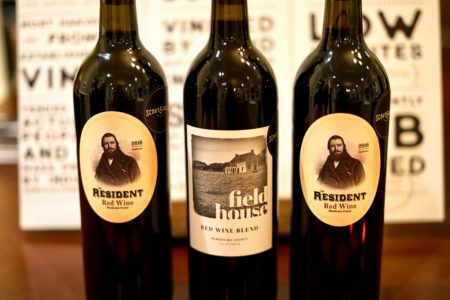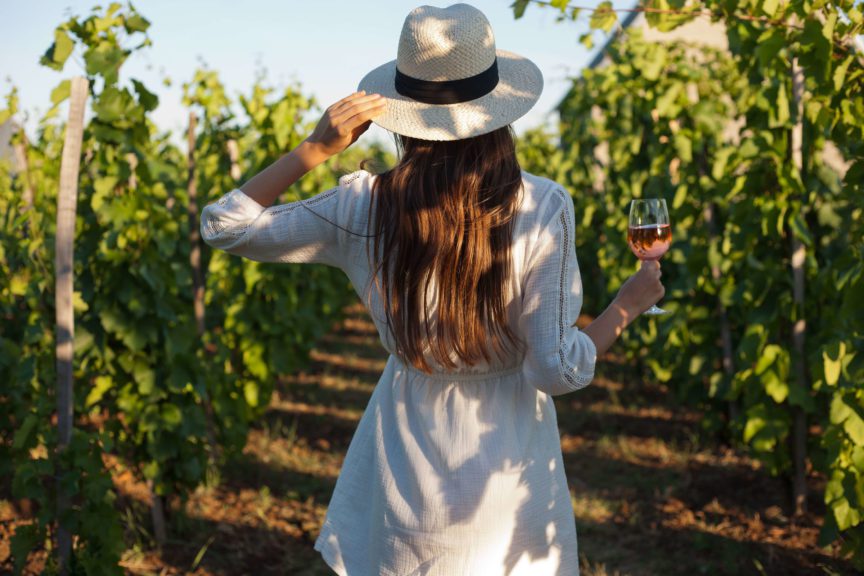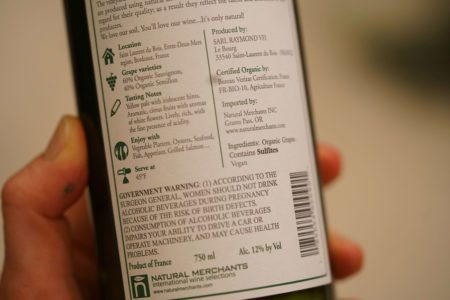
Jessica Comegys
Sulfites? Organic Wine? Headache-less Wine? Here is the truth about why you SHOULD drink wine. I’ve always wondered if the sulfites in wine are the culprit for that “yucky” feeling the next day. When I saw a bottle of sulfite-free, organic wine on my last grocery shopping trip, I couldn’t help myself. I had to test this theory. Is this a marketing gimmick, or does it really work? I may not be a sommelier, but I know wine. I’ve visited every winery from Spain to California and taken every educational tour you can imagine. I want to share with you what I’ve learned and hopefully debunk some of the myths floating around.
 Sulfites
Sulfites
First off, let’s talk about what sulfites are — and what they aren’t. “Sulfites” refers to sulfur dioxide, which is used to stabilize and preserve wine, giving it a longer shelf life. Sulfites are present in many foods from french fries to dried fruit. A small percentage of people, especially those who suffer from asthma, are known to be allergic to sulfites. The FDA estimates that less than 1% of the U.S. population is sulfite-sensitive, so it is rare, but if you do have a sulfite allergy (which can develop over the course of your life) it is more likely to reveal itself through something other than wine.
Facts:
Many foods have higher levels of sulfites than wine. The amount of sulfites in wine is highly regulated around the world. Any wine containing more than 10 parts per million (ppm) of sulfur dioxide must affix to the label “contains sulfites.”
- Wine contains about ten times less sulfites than most dried fruits, which can have levels up to 1000 ppm. If you regularly eat dried fruit and do not have any adverse reaction, you are probably not allergic to sulfites.
Myths:
- Sulfites in wine cause headaches. Medical research is not definitive on the relationship between sulfites and headaches. There are many other compounds in wine such as histamines and tannins that are more likely connected to the headache effect, not to mention alcohol.
- Red wine has extra sulfites, thus causes worse headaches. In the EU the maximum levels of sulfur dioxide that a wine can contain are 210 ppm for white wine, 400 ppm for sweet wines and 160 ppm for red wine. So, red wines typically contain less sulfites than white wine. They contain tannin, which is a stabilizing agent, and almost all red wines go through malolactic fermentation. Therefore, less sulfur dioxide is needed to protect the wine during the winemaking process.
- Sulfites are an unnatural part of the potential allergic reaction. Many people are against sulfites, because they feel they are an unnatural addition when making wine. While that view is valid, it is important to remember that sulfites are also a natural by-product of the yeast metabolism during fermentation. Even if there is no additional sulfur dioxide, your wine will still contain sulfites.
So Why Do I Get a Headache When I Drink Red Wine?
All of these scientific facts, however, do nothing more than say that sulfites are probably not the culprit for the well-known phenomenon of red wine headaches. Other possible reasons include, as I mentioned above, histamines, the alcohol content itself, and tannins. The latest evidence points to the latter: Buyer Beware: Mass Produced Wines – why it’s only $6.99! Some mass producers take on the role of the scientist, adding a dash of acidity or a hint of red to bring their wines in line with what consumers want. Some even buy already pressed grapes from high-end wineries and press them again! Winemakers can draw on a list of more than 60 government-approved additives that can be used to tweak everything from color to acidity to even thickness. Then the wines can be mass-produced in huge steel vats, which hold hundreds of gallons and are often infused with oak chips to impart the flavor of real oaken barrels. Every step of this fermentation process is closely monitored, and can be altered by changing temperature or adding more nutrients for the yeast. Eventually, the wine is mass produced, made available in your grocery store and sometimes sold for the same price as bottled water. Think Franken wine!
Recap: While I believe that less processed wines are healthier, they are also better wines. For people who want to drink better wines, thinking of wine as food is a useful approach to achieve that goal. You get what you pay for, and anything in excess can have less than desirable results.
Hot Tip: Most all old-world vineyards (think France, Spain, Italy) have always practiced sustainability in growing and harvesting, even before that was a term. Their growing concepts are naturally similar to what Americans are now asking for in the blanket term “organic.” Try to remember this when choosing a wine.
Now let’s talk about the benefits of wine!
- A healthier heart according to many reports confirmed that wine, in moderation, reduces the risk of cardiovascular disease and heart attacks. Swedish researchers at the Karolinska Institute reported that light drinkers who consumed wine cut their risk of dying prematurely by almost one third, and wine drinkers as a group had significantly lower mortality from cardiovascular disease and cancer.
- Wine offers anti-aging properties that could be helpful in the battle against free radicals that cause serious health issues. Wine is full of antioxidants that attack free radicals when they come lurking around. A study done by the University of Barcelona scientists found that the phenols in white wine had equal, if not higher antioxidants, than those in red wine. This is interesting because wine drinkers commonly believe red wine provides the most health benefits in moderate amounts. When you hear about healthy living and longevity, time and time again the Mediterranean diet comes up. At the core of that diet, beyond olive oil and vegetables, is wine. There is something magical inside the daily glass of wine that increases life span. That magic is “resveratrol.” Researchers at Harvard Medical School found that resveratrol activates a protein that acts as an anti-aging agent. The interaction increases overall health, thus promoting longevity. If that is not enough reason to drink a glass of wine, then I don’t know what else it. #roseallday
- Get happier gut bacteria with wine. We know our diets should contain probiotics like yogurt and sauerkraut for their natural gut-health benefits, but the good news is you can add your favorite wine to that list! Wine is a naturally fermented product, much like yogurt, pickles, kombucha,* and other bacteria-friendly foods, but early research has shown that wine may have more of a prebiotic effect, helping improve the bacterial composition of our gut. Bottoms up for good bacteria!
- Boost immunity with wine. Don’t stop taking your daily vitamins, but adding a glass of wine daily can give your immune system a boost. Moderate alcohol consumption can ward off infections and keep your immune system in check. Don’t get carried away, though. Excessive consumption can lead to negative effects, so drink smart.
- You could increase your calcium intake. Drinking milk is great, but you can do yourself a real favor and sip on a glass of wine. Red wine has high levels of silicon, which is great for your bone mineral density. It increases the density and reduces the chance of osteoporosis. Like warm milk, wine may help you doze off at night.
WINES TO TRY
 Scout & Cellar – a wine club developed by attorney turned sommelier that boasts clean crafted, no additives, organic, biodynamic, and boutique wine. Boutique you say? I’m in! I tried these California wines at a party and instantly fell in love with the sustainable practices of the winemaker not to mention the taste is on point. With several varieties, there is one for everyone’s taste. I personally love the cabernet.
Scout & Cellar – a wine club developed by attorney turned sommelier that boasts clean crafted, no additives, organic, biodynamic, and boutique wine. Boutique you say? I’m in! I tried these California wines at a party and instantly fell in love with the sustainable practices of the winemaker not to mention the taste is on point. With several varieties, there is one for everyone’s taste. I personally love the cabernet.
Price point: $19-42 with discounts on cases.
Where to buy: www.geauxshopthecellar.com
 Les Hauts De Lagarde – 2015 White Bordeaux blend. This is a delicious, ripe wine that is packed with apricot, apple and pear fruits. It’s tangy and fresh. This wine scored 90 points on the Wine Magazine’s Best Buy List.
Les Hauts De Lagarde – 2015 White Bordeaux blend. This is a delicious, ripe wine that is packed with apricot, apple and pear fruits. It’s tangy and fresh. This wine scored 90 points on the Wine Magazine’s Best Buy List.
Price: $13
Where to buy: Whole Foods
Loire Valley Wines – The entire estate is certified organic and with most of the vineyards being planted pre-1940 the yields are naturally low and all harvesting is done by hand. From Cabernet Franc to Chenin Blanc, these old-world wines from France are companion planted with fruit orchards such as cherries and artichokes which give the wine a notable aromatics and level of detail rarely seen. My favorites: Le Rocher des Violettes – Touraine Rosé & Vin de France Cabernet Franc
Price point: $22-38
Where to buy: Cuban Liquor
Don’t be afraid to try new varieties. Venture outside the Pinot Noir and Chardonnay box and get into some deep-rooted grapes. The white (blanc) French Bordeaux and Italian Barbera are full of dark cherry and ripe blackberry if you like a full-bodied red. I had a chance to visit a Cava winery in a little farming town outside Barcelona last fall. It produced the most amazing sparkling wine I have ever tried. Bonus, it didn’t give me that awful wine-head due to the lack of chemicals and added sugars. Next time you’re pursuing the wine section, venture out and try something new!


 Sulfites
Sulfites